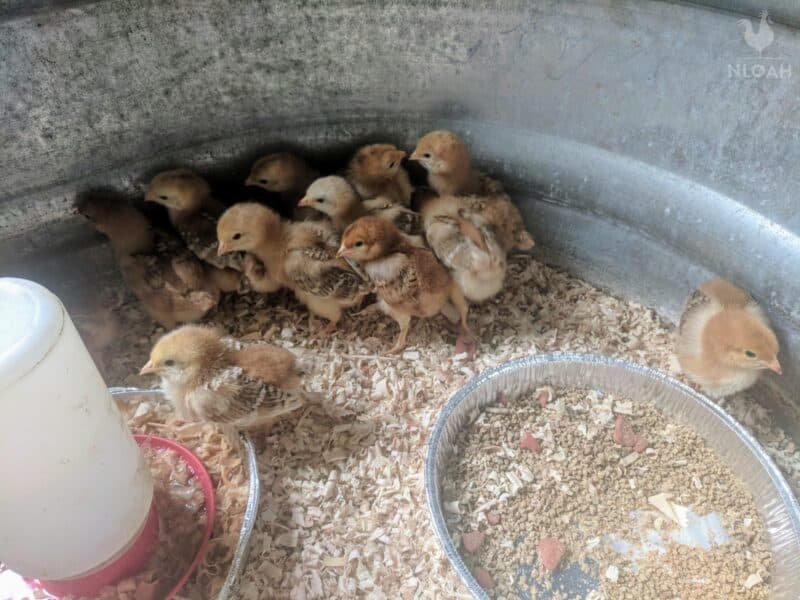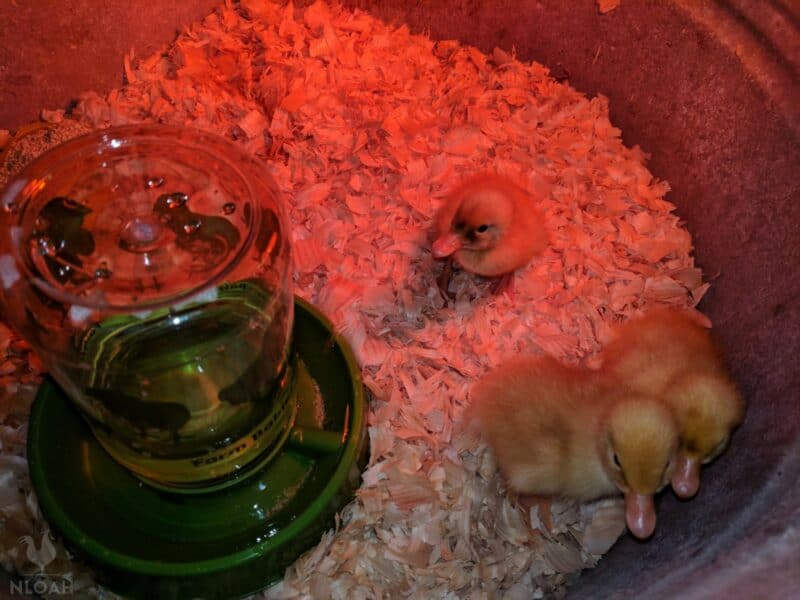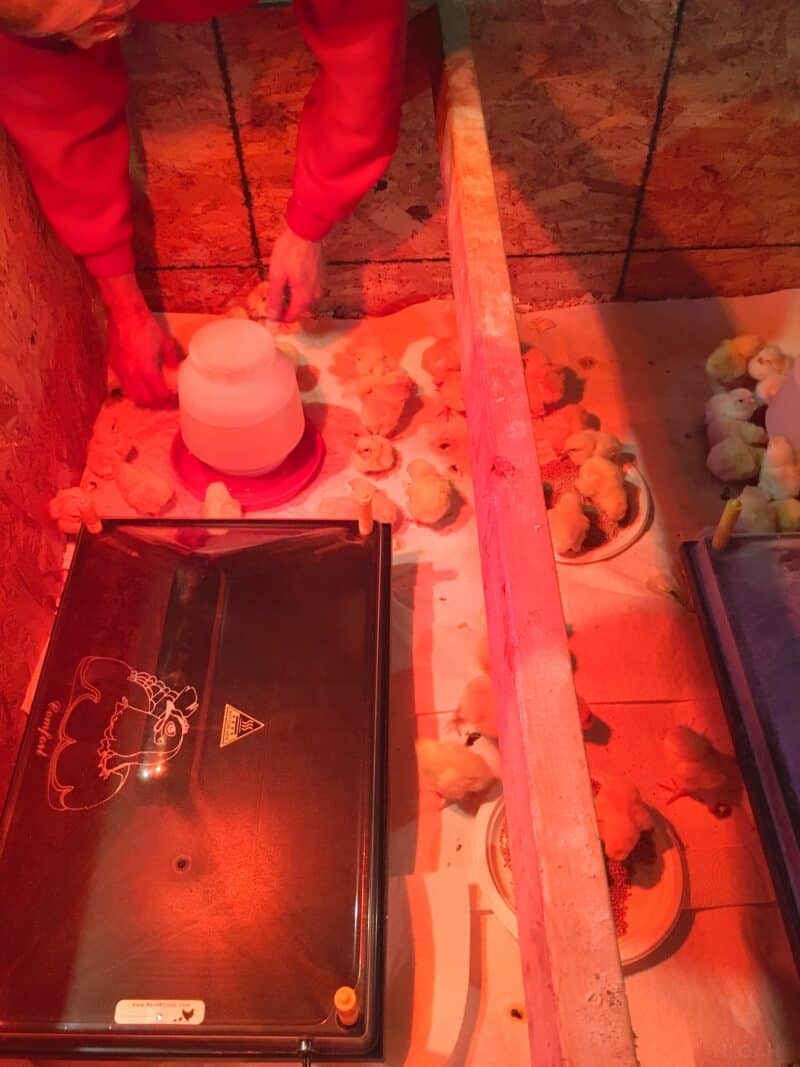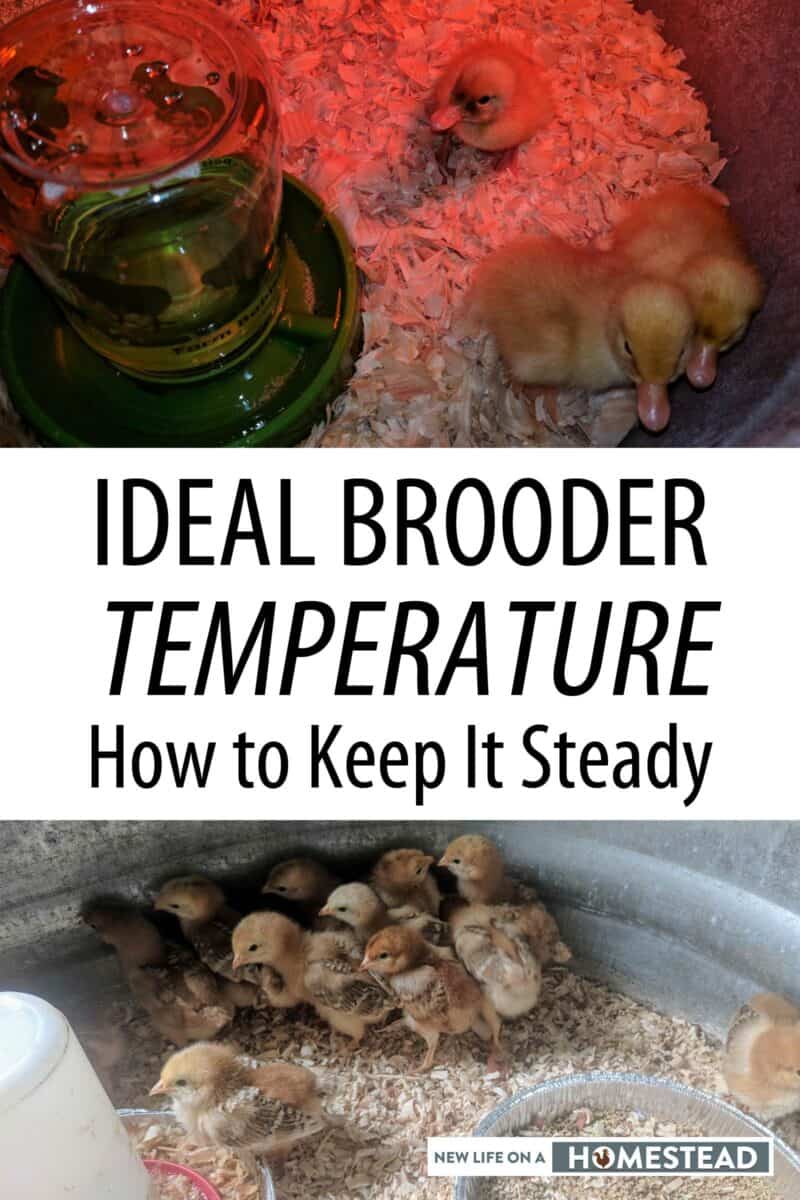Are you thinking about raising your own baby chicks? If so, you need to put some thought into your heat source and the ideal temperature for young birds.

Once you’ve hatched your baby chicks, you’ll need to keep them in a brooder for 7 weeks, until they are mature enough to handle outside temps. A brooder is an area to keep them in, like a box, which is rigged with a heat lamp, bedding material, and food & water.
It is very important to keep the brooder at the correct temperature. As your chicks get older, you’ll need to decrease the heat.
Brooder Temperature Chart
The ideal temperature to keep inside your chickens brooder is 90° F – 95° F (32° C – 35° C). This, however, will vary depending on the age of your birds.
Here is a chart for your reference:
| Age | Chicks | Ducks |
|---|---|---|
| 1 day | 90 F. | 90 F. |
| 1 week | 85 F. | 80 F. |
| 2 weeks | 80 F. | 75 F. |
| 3 weeks | 75 F. | 70 F. |
| 4 weeks | 70 F. | 60F. |
| 5 weeks | 65 F. | 50 F. |
| 6 weeks | 60 F. | 40 F. |
| 7 weeks | 55 F. | 40 F. |
Of course, keeping them at the ideal level of warmth is easier said than done. In this post, I’ll walk you through everything you need to know about the right brooder temperature and light requirements for young chickens.
Why You Need to Keep Chicks Warm
The good news about raising chicks is that it’s not too challenging as long as you remember the core principles – keep them warm, keep them safe, and keep them fed.
You can build a brooder out of just about anything, including an old Rubbermaid tote or an actual chicken coop.
Whatever you use, though, it’s important that you set up the environment to minimize stress among your birds. If your birds become stressed, it can affect their immunity and make them more susceptible to disease and other problems.
One of the easiest ways to keep your chicks stress-free is to keep them at the ideal temperature.
Chicks, like all other living creatures, do have somewhat of an ability to self-regulate their body temperature. However, this ability is refined as they get older and when they are young, they aren’t that great at doing it. They need a source of warmth until they start producing feathers in place of their down.
Although this doesn’t always happen at the same time for all breeds (and is somewhat dependent on the environment, too), most chicks will have feathers and can survive without supplemental heat when they are about 20 days old.
What is interesting is that chicks tend to feather out faster when the weather is cool – it’s as though they know what they need to survive!
That said, you still may find yourself needing to supply supplemental heat regardless. Chicks that are hatched in the early spring or the late winter usually need brooder warmth longer than those hatched in the summer or even in the late spring.
What is the Ideal Brooder Temperature for Chicks?
Keep your chicks in the brooder at around 95 degrees Fahrenheit to begin with. You’ll keep the chicks at this temperature for the first week, reducing it by five degrees each week until the brooder temperature is the same as the ambient temperature.
While this is something you will want to do gradually, keep in mind that chicks will feather out faster the more quickly you reduce the level of heat.
You might be wondering why you need to provide supplemental heat for your chicks when this is something that isn’t provided in the wild.
The answer is that, actually, it is provided in the wild – but by Mama Hen! When you watch baby chicks with their mothers, you will see that they remain very close to their mothers during the first few days. They’ll remain underneath the mother hen for warmth and come out only every now and then to eat or drink.

What Kind of Heat Source Should I Use?
When choosing the ideal heat source for your brooder, remember that each kind of brooder has different capabilities.
Some commercial box brooders come with their own adjustable thermostats, while a homemade brooder (which is what the vast majority of chicken keepers rely on) will provide heat with infrared heaters or incandescent light bulbs.
Incandescent Bulbs
Incandescent light bulbs are extremely common. In fact, these least expensive of all sources are some of the most common for people raising chicks in small batches (25 to 50 or so).
If you have a large brooding area, you can use two bulbs to accommodate some extra heat – and to give your chicks something to rely on if one bulb burns out and you aren’t around to change it.
To use this kind of heat source, you will screw each bulb into a fixture with a reflector. The reflector is important to help evenly distribute the heat. You can adjust it by raising or lowering it or by using a bulb with a higher or lower wattage.
Start with a 60- or 100-watt bulb depending on the size of your boroder and how many chicks you have in it.
Infrared Lamps
If you decide to use an infrared heater, you should do just fine with a single 250 watt lamp. This will provide enough heat for up to 100 chicks. You can buy these with clear or red bulbs, but red lamps are ideal.
Not only will the bulb last longer – it takes red bulbs longer to burn out – but it can also discourage picking. For whatever reason, when things have a red tinge, it makes chicks less aggressive toward each other.
Just keep in mind that infrared lamps can get hot. Therefore, you should use a porcelain socket instead of a plastic one (which can melt). The wires should be bent across the front so the lamp can’t touch the bedding if it falls. This can be a fire hazard otherwise.
To mount the heat lamp, hang it with an adjustable chain about 18 inches above the chicks. As they grow, you can simply raise the lamp. You’ll pull it up about three inches each week on average.
Again, infrared lamps can get hot, so it’s important to keep a close eye on your birds. You might notice them crowding around the outside of the brooder as they get older. If you notice this, it’s likely because it’s too hot in the brooder and the lamp needs to be raised.
Don’t hang the lamp by its cord – instead use a chain for a stronger, safer suspension. Try not to get the lamp so close to the brooder that it can catch the bedding on fire and do your best to protect the bulb from splashing water. Water splashed on a hot bulb can shatter it.
Heating Panels
You can also use heating panels to keep your chicks warm. These provide just as much heat as infrared heat lamps but use far less electricity. They are more expensive but can also be safer.
These panels project heat only directly beneath themselves, making it easier for chicks to move closer to the panel or away from it to stay comfortable. They come in all kinds of lengths and sizes and are easy to sanitize.

Again, these are expensive but I’ve noticed anecdotally that the panel – also known as heating plates – make my chicks feather out faster.
How to Measure Brooder Temperature
To measure the temperature in your brooder place a thermometer about two inch above the brooder floor. This will give you an idea of how cool or warm it is in the browser and whether things need to be adjusted.
Often, though, you won’t even need a thermometer. Watch the chicks and keep an eye on their body language to know whether it’s too hot or cold. If they’re cold, they might have diarrhea or crowd near the heat source. They may make a lot of noises, like peeping, too.
Piling is another sign that your brooder is too cold. This can suffocate chicks and be dangerous, so if you notice any piling at all, address it immediately.
Again, when chicks are too warm, they’ll move away from the heat and spend less time eating. They might pant and crowd each other at the outer edges, too.
What Kind of Light Do Baby Chicks Need?
Of course, you can’t neglect the light needed by baby chicks either!
Most commercial brooders are sold with their own small lights near the heat sources. However you can also easily build your own by adding a single 25 watt bulb. This should provide enough light for 10 square feet and you can scale up from there.
Make sure the brooder has light for the first 48 hours that your hicks are in it. IF the brooder receives natural daylight, you can shut the light off during the day.
However, if the light source also serves as your source of heat, don’t turn it off for more than half an hour a day (ideally, you should avoid turning it off during the coldest part of the day). That way, your chickens won’t panic when you try to acclimate them to natural light later on.
Failing to switch up the light cycle can also cause your chicks to panic if there is ever a power outage! Light affects the growth rate of chicks so it’s important not to keep them in the dark at all times.
Too much light, on the other hand, can cause cannibalism, stress, and aggression -so it’s important to strike the right balance.
What About Bedding?
Just as it’s important to keep the brooder warm and well-lit, you also need to keep it clean. Introducing bedding not only helps to keep the brooder warm but it also helps keep things sanitary.
From bacteria to parasites, coccidia to viruses, there are all kinds of threats around the farm that are just waiting to infec young chicks.
Bedding absorbs waste and provides a solid footing, while also insulating the bottom of the brooder to help keep your chickens warm.
You can use any kind of bedding you’d like, but options like wood shavings and chopped straw tend to be clean, affordable, warm, and readily available. Add fresh litter as needed, sucha s when it becomes soiled or wet.
A Few Other Tips for Brooding Chicks
When you first bring baby chicks home, it’s a good idea to make sure the brooder heat source and light source are both up and running for at least 24 hours before you ever put chicks inside. Check the temperature with a thermometer and make sure there isn’t a draft in your brooding area.
Exposing chicks to cold temperatures for even a day or two early in their lives can cause them to die from heart problems later on. It’s just too stressful, so make sure the area is warm!
Don’t rush to introduce your new baby chickens to the adult flock. Try to get them as close to the size of the rest of your birds as possible. Pecking order is real – and the sooner you introduce your chicks, the more likely it is that they will be picked on.
When you put your chicks outside, you’ll know if they are too cold because they will puff up their feathers and peep excessively.
Keep a close eye on your chicks once you move them out of the brooder. It can take some time for them to get used to conditions outdoors, and they are more vulnerable to predators and other threats at this time.
Ultimately, getting the brooder temperature and light right isn’t too hard – but it does take some fine-tuning to make sure it’s perfect. Happy hatching!

updated 12/14/2021 by Rebekah Pierce

A city girl learning to homestead on an acre of land in the country. Wife and homeschooling mother of four. Enjoying life, and everything that has to do with self sufficient living.
